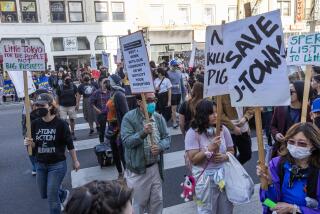Special Value of Occupied-Japan Items
- Share via
Our recent commentary on “made in occupied Japan” collectibles, which suggested that one did not have to put out big bucks for these post-World War II relics, brought a quick response from Robert Gee of Torrance, president of--naturally--the Occupied Japan Collectors Club.
“Most of the knickknacks that were produced early in the occupation (1947 to 1948) were in fact and are of little value today,” he wrote. “However, there are thousands of artifacts with the M.I.O.J. mark that I would give a pretty penny (so to speak) for.”
For example, Gee mentioned an atomic robot windup toy for which, he said, he would eagerly pay $300 “in the original box and mint”; or a bisque figurine that he estimated had a worth of about $75.
A telephone call to Gee, 60, a golf instructor, produced some more interesting information.
The club, he said, has 254 members, mostly in this country, who receive a newsletter four times a year. Membership, which includes the newsletter, a membership list and a club certificate, is $6.50, he said, and can be obtained from the Occupied Japan Collectors Club, P.O. Box 6154, Torrance, Calif. 90504.
Started With Ashtray
Gee said he started collecting made-in-occupied-Japan items about a decade ago.
“I was meeting with a patent attorney and was about to extinguish a cigarette in a high-relief dragon ashtray, when he said: ‘Don’t do that.’ ” As it turned out, the ashtray was a valuable made-in-occupied-Japan collectible, which served to whet Gee’s interest in the subject.
People are interested in collecting myriad items that were stamped “made in occupied Japan” or simply “occupied Japan,” he said, because of the short period of time in which they were produced. The brief time span “limits how much is available,” Gee said, and therefore enhances the collectible value of the items.
That time frame is directly linked to when U.S. Army Gen. Douglas MacArthur allowed Japanese merchants to begin exporting products after World War II--Aug. 17, 1947--and when the United States occupation of Japan ended--April 28, 1952. In that time period, Japanese producers were under instructions to put the made-in-occupied-Japan mark on all products exported to the United States.
Included were a wide variety of items-turned-collectibles, from Toby mugs to watches to clothes.
“Who saved these items?” Gee asked. Now, he said, if they still exist at all, many are difficult to find and command some interesting prices.
For example, he said, a Toby mug in MacArthur’s likeness and in top condition “has to start at $60.”
Usually, Gee said, such items are stamped on the bottom with the made-in-occupied-Japan mark. If collectors new to the field are concerned about fakes, he suggested applying nail polish remover to the embedded, embossed or acid-etched mark; if the mark comes off, the item is a fake.
For individuals serious about collecting in this field, Gee recommends a two-volume set on the subject: “The Collectors Encyclopedia of Occupied Japan Collectibles,” by Gene Florence (Collector Books, Schroeder Publishing Inc., P.O. Box 3009, Paducah, Ky. 42001). The two volumes were published in 1977 for $12.95 each.
Gee said he is disposing of some of the 4,000 made-in-occupied-Japan items in his collection to get a firmer handle on current market prices so that he can publish a market guide on the subject.
And, he said: “I’m trying for a convention in Chicago for next year.”


